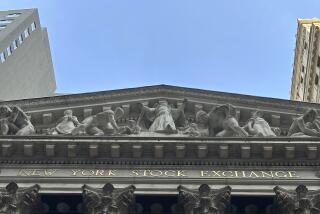As ‘Whisper’ Profit Estimates Boom, One Analyst Tries to Weed Out Hype
- Share via
Those earnings whispers have turned into a roar.
Many observers say it pays to listen to “whisper” numbers, the unofficial yet increasingly popular corporate earnings estimates that circulate among traders and investors every quarter.
But at least one number-cruncher, research director Charles Hill of Boston-based earnings tracker First Call/Thomson Financial, advises investors to be careful about buying or selling shares based on circulating whisper estimates.
Those estimates, Hill warns, are more readily available to average investors--via the Internet--than ever before. That also makes them far more easily manipulated.
The danger in buying a stock based on an overly bullish whisper number is that the shares could easily tank if the company reports earnings below that level--which has happened plenty of times in recent quarters.
Hill has gone a different route: He calculates “hisper” numbers, based on the consistency and magnitude of each company’s recent quarterly earnings surprises--rather than on word of mouth and Web postings.
In other words, if a company has routinely beaten estimates over the last four to eight quarters, Hill looks at the margins by which the official estimates have been topped, and works with those to calculate the potential earnings surprise in the current quarter.
Whisper estimates--whose description derives from the supposed practice of company insiders whispering to their favorite Wall Street analysts the real scoop on how the company is doing, or analysts simply giving their favorite clients the straight skinny--have become an open secret in recent years, thanks largely to the Internet.
These days, they may as easily come from individual investors and anonymous sources as professional analysts. Among the Web sites that track them:
https://www.earningswhispers.com; https://www.whispernumber.com;
https://www.thewhispernumber.com; https://www.jagnotes.com; and
https://www.streetiq.com.
Because analysts tend to be conservative with their official estimates, while whisperers tend to be much more rosy, companies often get punished when they beat the earnings consensus but fall short of the whisper.
The whisper phenomenon grew because the numbers did have merit. The forecasts have tended to be more accurate than First Call’s official estimates, which are based on a survey of analysts, and are a more useful trading tool, according to a study by professors Mark Bagnoli and Susan G. Watts of Purdue University and Messod Daniel Beneish of Indiana University.
They found that buying stocks of companies whose whisper numbers were higher than the First Call consensus estimate five days before the earnings announcement, then selling them the day after the announcement, was a profitable strategy.
Likewise, short-selling, or betting against stocks with higher official estimates than whispers, also proved to be profitable.
“In other words, the market moves more in line with the whispers than the official estimates,” Watts said.
But that 1995-97 study, which culled whispers from news reports and Internet postings, predates the Web sites devoted to whispers.
Now, not only is there no official or central source for whisper numbers, they can vary greatly.
Hill and the academics alike warn that whispers posted on message boards or at the growing legion of whisper Web sites with official-sounding names can be unreliable. Some of these interactive sites base their numbers at least in part on whispers entered by anonymous users, which can render them as scientific as an MTV phone-in poll.
“You don’t really know where these sites are getting these numbers or how they compute them, whether they’re pulling them off a chat room or what,” Hill said. “They definitely can be manipulated by people.”
Watts agreed, saying that because of the growing clout of whispers, “people may see an opportunity” to promote or attack a stock.
Hill’s hispers, by contrast, are designed to unemotionally correct analysts’ forecasts, which tend to be artificially low because analysts allow companies to wink and whine about slow growth, then consistently beat the “official” estimates.
Analysts go along with that game in part because it makes everybody happy: Analysts look good if the companies they follow--and whose stocks they recommend--do well, and investors like consistent “Street beaters.”
Watts said that she and her colleagues are studying the merits of Hill’s hispers. “So far, we’ve found that they are more accurate than First Call’s own consensus,” she said. The team has not yet looked at whether they are more on-the-money than whisper estimates. “We do know that hispers are more pessimistic than the whispers on average, but more optimistic than the official numbers,” she said. “Chuck may well be onto something.”
Though hisper numbers are only an occasional feature at First Call’s Web site (https://www.firstcall.com) and not an official product, Hill drafted a list of second-quarter earnings surprise candidates for The Times based on his hisper analysis of companies in the technology and financial services sectors. They appear in the accompanying chart.
Hill said he would prefer a perfect world in which neither hispers nor whispers were needed. “The bottom line is, companies should give better guidance,” he said.
In the meantime, one of First Call’s rivals, earnings-tracker IBES International of New York, has devised its own, similar method for predicting earnings surprises. The surprise factor, it seems, has become a cottage industry as investors focus as much on earnings versus expectations as on the bottom line.
To identify surprise candidates, IBES screens its database for companies that have either topped or fallen short of estimates for six straight quarters. If the company has a winning streak and analysts’ estimates have been heading higher for the last 30 days, IBES considers it a candidate for a positive earnings surprise in the current quarter; those on losing streaks with estimates heading downward are negative surprise candidates.
Morgan Stanley Dean Witter (ticker symbol: MWD) is expected to follow the lead of other brokerages and post a positive surprise for its quarter ended May 31, when it reports later this week. Lehman Bros. (LEH) and A.G. Edwards (AGE) recently beat expectations, just as IBES predicted.
Other early-reporting companies expected to do well include Darden Restaurants (DRI), which runs Olive Garden and other eateries.
Analysts expect earnings of $1.13 a share for Morgan Stanley and 40 cents for Darden.
*
Times staff writer Josh Friedman can be reached at [email protected].
(BEGIN TEXT OF INFOBOX / INFOGRAPHIC)
If History Is Any Guide ... Charles Hill, research director at First Call/Thomson Financial, expects these technology and financial companies to beat analysts’ consensus expectations for second-quarter earnings per share (EPS), according to his “hisper numbers.” The name mocks whisper numbers, the unofficial estimates that circulate among traders and investors. Hill’s hispers are based on his analysis of the consistency and magnitude of each company’s recent earnings surprises, rather than word of mouth and Web postings. Of course, whether the stocks will rally even if the companies meet or exceed the hisper number remains to be seen. Ticker Monday Consensus “Hisper” Company symbol close EPS est. estimate Advanced Micro AMD $91.81 $1.13 $1.20 America Online AOL 54.50 0.11 0.12 Broadcom BRCM 147.50 0.19 0.21 Cisco Systems CSCO 68.94 0.15 0.16 Conexant CNXT 55.06 0.22 0.24 Cypress Semiconductor CY 51.00 0.47 0.49 Donaldson Lufkin DLJ 43.94 1.04 1.25 EMC EMC 83.50 0.18 0.19 Goldman Sachs GS 91.63 1.37 1.60 JDS Uniphase JDSU 127.31 0.12 0.13 LSI Logic LSI 66.50 0.29 0.31 Merrill Lynch MER 118.50 1.69 1.90 Microsoft MSFT 73.69 0.42 0.45 Morgan Stanley DW MWD 84.44 1.13 1.35 Motorola MOT 34.25 0.23 0.24 Oracle ORCL 86.00 0.25 0.26 PaineWebber Group PWJ 51.06 1.04 1.10 PE Biosystems PEB 58.00 0.26 0.27 PMC-Sierra PMCS 193.00 0.19 0.20 Qualcomm QCOM 65.19 0.27 0.28 Scientific-Atlanta SFA 70.31 0.26 0.28 Siebel Systems SEBL 168.19 0.18 0.20 Sun Microsystems SUNW 95.44 0.33 0.34 Teradyne TER 83.38 0.74 0.78 Texas Instruments TXN 87.75 0.30 0.31 Veritas Software VRTS 140.19 0.12 0.13 Xylinx XLNX 90.00 0.25 0.26 Yahoo YHOO 139.06 0.10 0.11 *
Source: First Call/Thomson Financial
More to Read
Inside the business of entertainment
The Wide Shot brings you news, analysis and insights on everything from streaming wars to production — and what it all means for the future.
You may occasionally receive promotional content from the Los Angeles Times.










